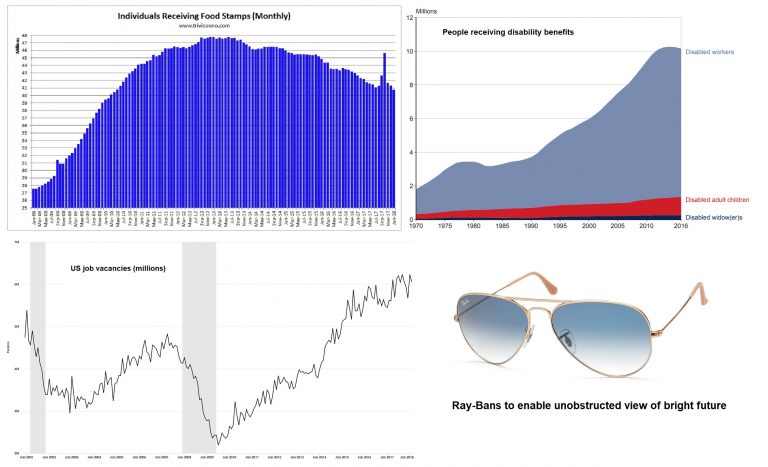“Literally On Fire” This week brought forward more evidence that we are living in a fabricated world. The popular story-line presents a world of pure awesomeness. The common experience, however, falls grossly short. There are many degrees of awesomeness, up to total awesomeness – which is where we are these days, in the age of total awesomeness, just a short skip away from the Nirvana era. - Click to enlarge What is Nirvana, you may wonder? We only know for sure that Nirvana is what the stock market has priced in – other than that, we will have to wait and see On Tuesday, for example, the Labor Department reported there were a record 6.6 million job openings in March. Based on the Labor Department’s data, there
Topics:
MN Gordon considers the following as important: 6) Gold and Austrian Economics, 6b) Austrian Economics, Chart Update, Featured, newslettersent, On Economy
This could be interesting, too:
Nachrichten Ticker - www.finanzen.ch writes Die Performance der Kryptowährungen in KW 9: Das hat sich bei Bitcoin, Ether & Co. getan
Nachrichten Ticker - www.finanzen.ch writes Wer verbirgt sich hinter der Ethereum-Technologie?
Marc Chandler writes March 2025 Monthly
Mark Thornton writes Is Amazon a Union-Busting Leviathan?
“Literally On Fire”This week brought forward more evidence that we are living in a fabricated world. The popular story-line presents a world of pure awesomeness. The common experience, however, falls grossly short. |
 There are many degrees of awesomeness, up to total awesomeness – which is where we are these days, in the age of total awesomeness, just a short skip away from the Nirvana era. - Click to enlarge What is Nirvana, you may wonder? We only know for sure that Nirvana is what the stock market has priced in – other than that, we will have to wait and see |
| On Tuesday, for example, the Labor Department reported there were a record 6.6 million job openings in March. Based on the Labor Department’s data, there were enough jobs available – exactly – for the 6.6 million Americans who were actively looking for a job. What a remarkable feat!
In fact, this is the first time there’s been a job opening for every unemployed person since the Labor Department began keeping track of job openings nearly 20 years ago. Chris Rupkey, chief financial economist at MUFG Union Bank, took one look at the jobs and labor report and exclaimed: “The labor market is literally on fire it is so hot with job openings!” Now, obviously, not every person is qualified for every job. A person’s skills often don’t match up with those required for a certain job. This may be why the unemployment rate is 3.9 percent, not 0.0 percent. Still, doesn’t the perfect harmony of a precise 1:1 ratio of job openings to unemployed persons strike you as being contrived? Well, that’s because it is. This statistic, like many of the official numbers, is fake. It’s a fabrication. And it doesn’t stand up to the empirical first-hand experience of broad cross-sections of the population. |
|
FabricationsIs the labor market really so hot with job openings that it’s literally on fire? The Labor Department’s fake numbers say so. Nonetheless, let’s cross check their accuracy. To clarify, there are various ways to reduce the unemployment rate. There are hard ways. And there are easy ways. Reducing the unemployment rate by increasing the number of people that are working is hard. It takes time, hard work, and discipline. Moreover, it takes strong economic growth. But no one likes time, hard work, and discipline. Instead, everyone likes the opposite. Everyone likes instant gratification, lethargy, and flexibility – especially government statisticians. Hence, the quicker, easier, and simpler way to reduce the unemployment rate is to stop counting some of the people that fall in the unemployed category. Make them, in effect, disappear. Problem solved! Here, Erik Sherman, writing for Forbes, explains how the fiction is written:
This is how statistics are conveniently fudged and fabricated. Of course, the disappeared unemployed didn’t actually vanish from the face of the earth. They were merely disappeared from the unemployment rate statistics. Still, fake numbers don’t somehow make the economy awesome. Rather, they make the economy a constructed work of fiction. The sole purpose of these fake numbers is political expedience. |
US Employment Population Ratio, 1998 - 2018 |
How to Get Ahead in Today’s EconomyAnother cross check to the Labor Department’s fake numbers is wage growth. An economy with a low unemployment rate should be an economy with high worker demand. An economy with high worker demand should be an economy where workers have the opportunity to name their price. In short, today’s economy – the one with an unemployment rate of 3.9 percent – should be an economy with strong wage growth. But wage growth isn’t strong. In fact, any wage growth there is, has been more than consumed by inflation. People may get a raise, they may make more money in a nominal sense, but inflation eats up the extra money and then some. |
US Average Hourly Wage Growth and US Headline CPI, 2008 - 2018 |
How is it possible that the unemployment rate is 3.9 percent, yet wage growth is softer than a warm pile of mashed potatoes? Simple. The unemployment rate is fake. So what’s an industrious fellow to do, to get ahead in today’s economy? Here are several options:
As far as we can tell, it’s best to simultaneously do both Option 1 and Option 2. While it may at times be masochistic, and there’s no guarantee of success, if you stay interested, and keep your sense of urgency, you’ll always have hope. And having a little hope, no doubt, will put you ahead of nearly everyone else. |
Charts by: Matt Trivisonno, US Social Security Administration, St. Louis Fed
Chart and image captions by PT
Tags: Chart Update,Featured,newslettersent,On Economy




